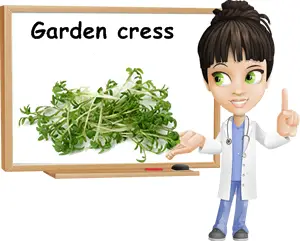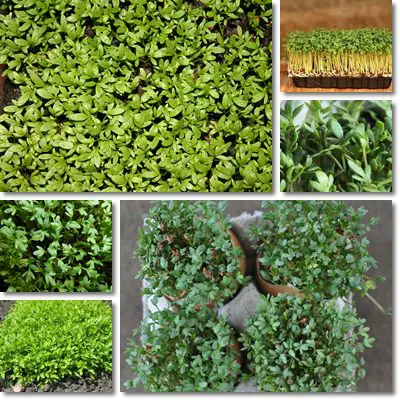Garden cress or simply cress (Lepidium sativum) is a peppery garden vegetable related to watercress, maca or Peruvian ginseng and pepperwort. Garden cress boasts a significantly higher vitamin content than watercress and several impressive health benefits. The nutrients behind its health effects are vitamins A, C and K, all of which have a beneficial action on the cardiovascular and immune systems in particular. For instance, it is highly protective of cardiovascular health, preventing arterial calcification and reducing overall heart disease risks.
Moreover, its generous vitamin A content helps maintain good vision and supports the immune function, while special biologically active compounds exhibit some pretty amazing anticancer properties. Common names for garden cress include: cress, garden pepper cress, pepperwort cress, pepperwort pepper grass, mustard and cress or poor man’s pepper. Notice how most of these name are references to the vegetable’s spicy flavor, similar to that of pepper or mustard.

What does garden cress look like?
Garden cress has tiny, meaty, slightly elongated green leaves and long white-green, feeble-looking stems with stringy white roots. It is readily available in the form shouts and best harvested when the shouts reach 5-10 cm in height. If left to mature, the plant can easily reach 50-60 cm in height. There are several varieties available, including wrinkled or crinkled ones (called as such as a result of their curled leaves). Seeds are tiny and red brown in color and are used as seasoning in Asian cooking under the name ‘haloon’, where they are almost just as popular as garden cress itself.
What does garden cress taste like?
Both the leaves and seeds are used for seasoning dishes. Garden cress leaves have a peppery, sharp flavor, similar to that of radishes. However, growing conditions can influence their flavor to some extent. For instance, growing the plant in pots, bowls or even flat plates and keeping it on your windowsill will help temper its flavor and make it milder-tasting. Garden cress can even be sprouted from seeds on wet or moist paper towels or cotton wads.
As a result of it tiny leaves and enjoyable spicy flavor, garden cress is often called a micro-green and used in fine cooking. The leaves are best used fresh because they cannot be successfully be preserved. Also, garden cress leaves are quite flavorful which is why they are often used alone so as to not overwhelm other spices. Surprisingly, they go well in sandwiches or fresh, green salads.

What is garden cress good for?
Find out below what are the top 6 nutrition facts and health benefits of garden cress:
Recommended for good vision and eye health
Like most green vegetables, garden cress is a rich source of vitamin A and antioxidants with vitamin A activity such as carotenoids. Vitamin A is highly protective of eye health and a generous intake serves to improve visual acuity and night vision. Carotenoids such as beta-carotene, lutein and zeaxanthin protect the retina and macula lutea from free radicals from light and help prevent the development of cataracts, macular degeneration (loss of central vision) and other degenerative conditions of the eye.
Supports the immune function
Garden cress contains 69 mg of vitamin C as well as 346 μg of vitamin A, two nutrients of pivotal importance for good immunity. Vitamin C increases the aggressiveness of white blood cells and boasts potent antibacterial and antiviral activity. Vitamin A helps prevent viruses or bacteria from breaching our system through sensitive mucous membranes at the level of the eyes, nose, mouth, throat, lungs and stomach. 100 g of garden cress contains more vitamin C than oranges and around 40% of the RDA of vitamin A.
Good for cardiovascular health
Garden cress is good for cardiovascular health because it maintains artery health and reduces overall risks of heart disease. The high amount of vitamin C in garden cress helps keep arteries clean from cholesterol and flexible due to the fact that it stimulates the production of collagen, a structural protein responsible for their elasticity. Secondly, garden cress is rich in vitamin K, with an estimated 420% of the RDA of the nutrient (541μg). Vitamin K prevents excess calcium from either diet or food supplements from depositing on artery walls or heart valves, a condition known as arterial calcification.
Basically, arterial calcification reduces blood vessel elasticity, increasing atherosclerosis, stroke and heart attack risks, especially when paired with high blood pressure (hypertension). It is highly recommended to increase your intake of vitamin K-rich foods such as chard, endives, watercress or garden cress when having a high calcium intake, unless you are prescribed anticoagulants.
Also see benefits of watercress.
Prevents bone demineralization and osteoporosis
With over 400% vitamin K, garden cress promotes strong, healthy bones and teeth. Vitamin K helps direct calcium into bones, not artery walls, joints or heart valves and regulates the process of bone renewal by maintaining certain hormonal balances. This preserves bone integrity and helps prevent bone demineralization resulting in brittle bones, fractures and osteoporosis. However, garden cress is good for your bones as long as you also have a sufficient calcium intake to further contribute to bone matrix composition and magnesium to enhance its absorption and ensure it goes into bones and teeth and not somewhere else.
Reduces cavity risks and maintains healthy gums
Garden cress was shown to contain gluconasturtiin, a compound occurring naturally in cruciferous vegetables. Gluconasturtiin is responsible for the spiciness of vegetables such as horseradish and watercress and has a repelling effect on harmful organisms. It is believed to stop the proliferation of gum-damaging bacteria that cause dental decay. At the same time, the high content of vitamins in garden cress contributes immensely to keeping gums and teeth in good health.
Exhibits cancer-preventive properties
Gluconasturtiin, a biologically active compound in garden cress and other related vegetables, appears to suppress the production of certain enzymes believed to cause tumor growth. The antioxidant vitamins in garden cress, notably vitamin C, provide antioxidant, anti-inflammatory and anticancer protection as well. However, the leaves will have to be consumed raw because cooking heat destroys it.
Other uses of garden cress
Traditional medical practices also recommend garden cress seeds for relieving constipation due to their mucilage content and offering relief for indigestion. In addition to this, the seeds were recommended to asthmatics or people suffering from various respiratory problems such as bronchitis to aid in recovery and improve overall lung health. It was theorized that the mucilage would form a protective coating over irritated mucous membranes, allowing them to heal.
